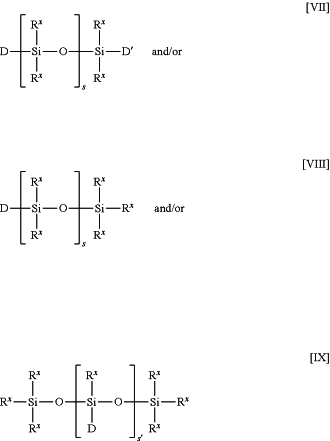| CPC C08G 18/797 (2013.01) [C08G 18/12 (2013.01); C08G 18/5096 (2013.01); C08G 18/61 (2013.01); C08L 75/04 (2013.01); D06B 1/00 (2013.01); D06M 15/564 (2013.01)] | 14 Claims |
|
1. Polyurethane/polyorganosiloxane and/or polyurea-polyorganosiloxane compounds and salts thereof that contain at least one structural element of formula [II]
 and Ri is a structural element of formula [III]
 in which V has the structure [V]:
 in which n=0 to 10, and X is derived from aromatic, cycloaliphatic or aliphatic, at least divalent, linear or branched mono- or polyisocyanates and their mixtures of isomers and/or mixtures of different diisocyanates having up to 15 carbon atoms that were subjected to a carbodiimidation reaction, wherein said reaction yields a compound of formula [XII]:
 wherein —V— is as defined above, and x≥2;
P1 is derived from polyols or polyamines adhering to formula (XIII) where P1 is a polymer moiety selected from the group consisting of a polycarbonate, polyester, polyether, polyacrylate, polyolefin, polydimethylsiloxane, polylactone, polyamides, polyurea, polyurethane, copolymers thereof, and mixtures of such polymers, terminated with hydroxyl- or amine groups:
 wherein g≥1, and Y=—NRA— or —O—, and RA represents hydrogen or a linear, branched, cyclic, saturated, unsaturated or aromatic hydrocarbyl radical with up to 20 carbon atoms, which may additionally contain several groups selected from —O—, —C(O)—, —NH—, tertiary amines, or quaternary ammonium compounds;
P2 is derived from an α,ω-primary or secondary amino- or hydroxyalkyl- or hydroxypolyetheralkyl-functionalized polyorganosiloxane having the structure
 in which s=2 to 500 and s′=1 to 3, D and D′ are primary or secondary hydroxy- or aminoalkyl- or hydroxypolyether-terminated organic radicals having up to 200 carbon atoms, which is capable of undergoing a chemical polyaddition reaction with [XII], D and D′ are additionally the same or different, and Rx is a linear, branched, cyclic, saturated, unsaturated, aromatic, substituted or unsubstituted hydrocarbyl radical having up to 20 carbon atoms, which may additionally bear amino or quaternary ammonium compounds or hydroxyalkyl or hydroxypolyetheralkyl groups, whereby P may provide a comb-like structure, P2 is selected independently of P1;
P3 is a linear, branched, cyclic, saturated, unsaturated, aromatic, substituted, or unsubstituted group with up to 20 carbon atoms, which is converted to its salts by a protonatable or deprotonatable group -J-, to enable the polymer to achieve water solubility, emulsifiability and/or dispersibility, where, x, y, and z are all integers ≥1;
and a chain extender —U— selected from aliphatic, monovalent, divalent or polyvalent, linear or branched polyols or polyamines with up to 15 carbon atoms, or from primary or secondary amino- or hydroxy-terminated polyethers with a molecular weight of up to 1000 g/mol.
|